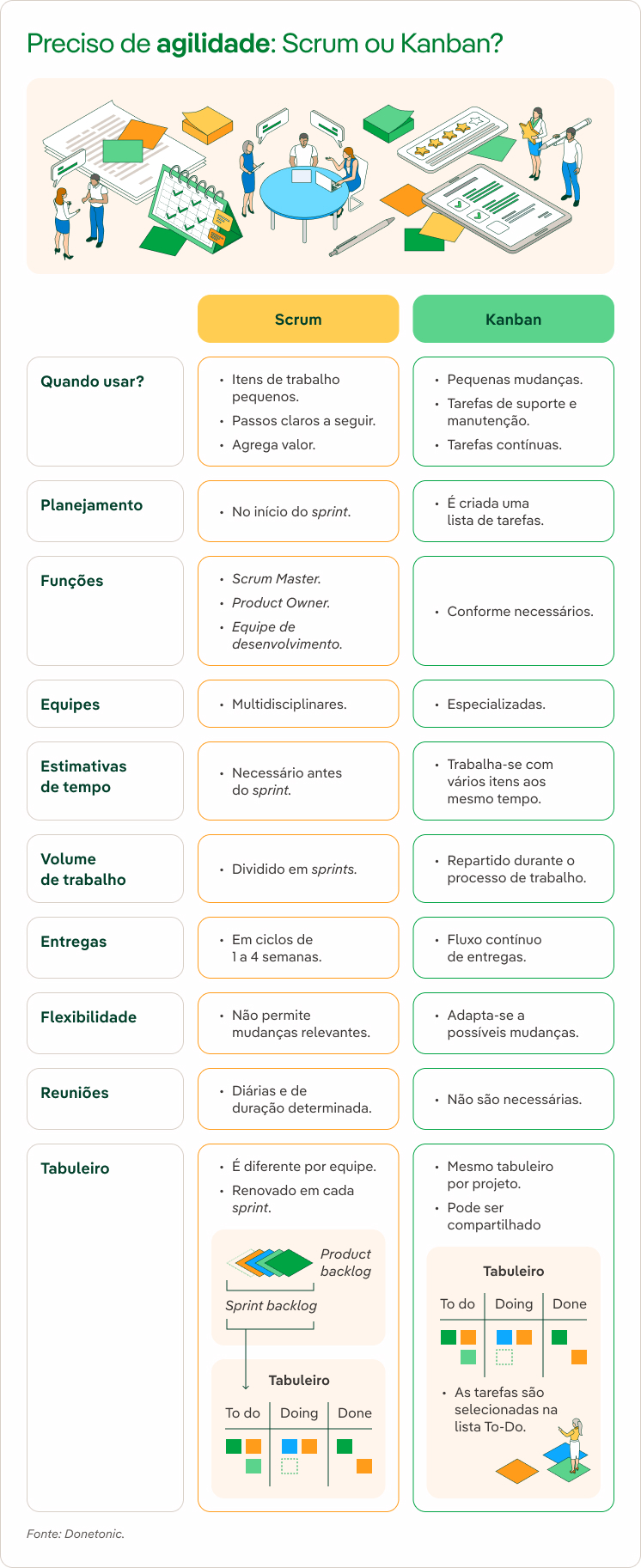O que é a metodologia 'Agile'?
'Agile': divide e vencerá
Empresa Treinamento Produtividade profissional
A metodologia Agile é um sistema de trabalho que está mudando o desenvolvimento de projetos de muitas empresas, entre elas a Google, Amazon ou Microsoft. Esse novo conceito faz sucesso em todo o mundo e chegou para ficar. A chave de seu sucesso? Organizar e distribuir o trabalho de uma forma rápida e flexível entre diferentes equipes multidisciplinares. Vamos explicá-la.

Valores da metodolia Agile
A metodologia Agile está mudando o DNA das empresas. Com quase 20 anos de existência, esse tipo de metodologia ágil já é adotado por várias empresas de diversos setores ao redor do mundo. Ligada originalmente à indústria do software, versátil e orientada para resultados, se destaca pela velocidade e flexibilidade que imprime ao desenvolvimento de projetos, com entregas parciais ao cliente a cada quinze dias aproximadamente.
A metodologia Agile mantém a direção sem cair na rigidez dos conhecidos métodos em cascata ou waterfall. Estes planejam o trabalho desde o início, sem dar lugar a imprevistos. De forma que quando aparecem é impossível reagir a tempo. O agilismo, no entanto, mantém a capacidade de adotar a melhor opção a cada momento sem comprometer o projeto. Os métodos Agile mais populares do momento são o Scrum e o Kanban.
A metodologia Agile surge em fevereiro de 2001 quando 17 especialistas em desenvolvimento de software elaboraram, durante um encontro nos Estados Unidos (Utah), um documento a favor dos novos métodos ágeis de atuação.
Esta folha de 12 pontos, conhecida como Manifesto Agile, apostava em uma organização do trabalho que desse mais fluidez ao desenvolvimento de projetos. Desde o início, a metodologia Agile reivindica 4 valores:
Desses 4 valores derivam os 12 postulados do manifesto que defendem aspectos como a satisfação do cliente, o trabalho em equipe, o diálogo cara a cara, as entregas rápidas e contínuas de software funcional, as revisões periódicas, a simplicidade, a atenção pela excelência técnica, o desenvolvimento sustentado ou a reflexão para se autocorrigir e melhorar.

Tipos de liderança de negócios
Liderança empresarial: quais são os principais estilos?

Conselhos de superação pessoal
Conheça seu máximo potencial e alcance seus objetivos.

Coworking
A revolução do espaço de trabalho.

Empresas unicórnio
As 'startups' sonham com unicórnios?
Princípios e vantagens da metodoligia Agile
A metodologia Agile proporciona rapidez e flexibilidade ao desenvolvimento de projetos, mas como o faz? O aspecto mais significativo é sua organização do trabalho. Em vez de abordá-lo como um todo, divide-o em partes pequenas para recompô-lo como um quebra-cabeça.
A execução das diferentes tarefas e sua posterior montagem recai em equipes multidisciplinares de indivíduos que devem ter um alto grau de motivação e autonomia. As vantagens dessa metodologia ágil consistem no seguinte:
- Ao dividir um trabalho em pequenas partes, consegue fazer com que os imprevistos afetem apenas uma parte do conjunto, que poderá ser retificada em pouco tempo.
- Com a colaboração entre equipes se consegue velocidade, fluidez e dinamismo. As contribuições de uns e de outros enriquecem o resultado final.
Requerimentos da metodologia Agile
O aspecto mais importante para a implementação da metodologia Agile é a liderança e a mudança de cultura empresarial. Saber dialogar e motivar as equipes para vencer suas resistências, convencê-las dos benefícios e envolvê-las na mudança. O compromisso com o modelo é fundamental para seu sucesso.
A divisão dos projetos é efetuada em marcos ou tarefas. Estas só admitem três estados: pendente, em processamento ou finalizada. O tempo de execução deveria ser de poucas horas a no máximo alguns dias, e são resolvidas uma por uma. As tarefas mais próximas da execução estarão melhor definidas do que as que abordaremos dentro de semanas ou meses.
As reuniões diárias também são importantes. Nesses encontros, breves e à primeira hora da manhã, os membros da equipe se informam entre si sobre o estado de suas tarefas. O líder do projeto adquire uma visão geral e pode fazer derivar recursos para as partes que mais necessitem deles. Além disso, essas reuniões servem para unir a equipe e envolver todos os seus integrantes.
A metodologia Agile necessita de técnicas muito visuais e ferramentas próprias de gestão de projetos para conseguir excelentes resultados. É o caso do Jira, Trello, Wrike ou Asana, entre outros.
A transformação digital da sociedade fez com que a metodologia Agile seja válida em quase todas as áreas empresariais, não só na tecnológica. Só exige um projeto, alguém capaz de implementá-la e, sobretudo, cumprir os princípios de iteração, revisão, adaptação e vontade de melhorias constantes.
Métodos Agile
Os métodos Agile mais populares da atualidade são o Scrum e o Kanban. Conheça as características e peculiaridades de cada um deles.

Casos de sucesso das metodologias ágeis
As metodologias ágeis transformaram a maneira como as organizações gerenciam seus projetos. Esse tipo de organização proporciona maior flexibilidade, eficiência e, principalmente, capacidade de adaptação. Confira alguns exemplos de empresas de diferentes setores que adotaram a metodologia Agile com grande sucesso:
- Spotify. A empresa criou seu próprio modelo baseado em Scrum e Kanban para atender às necessidades específicas de seu setor. O diferencial de sua abordagem é o uso de um sistema de tentativa e erro para realizar experimentos em ambientes de baixo risco, com a ideia de que errar antes permite aprender e melhorar com antecedência. Além disso, o Spotify usa, como em qualquer outro modelo ágil, funções e grupos. As equipes são divididas em squads, ou seja, pequenos grupos multidisciplinares de 6 a 12 pessoas trabalhando juntas. Esses grupos são organizados em tribos, que geralmente não ultrapassam 100 pessoas e são lideradas por um líder, o que permite que a cultura seja alinhada em nível global. Esse formato permite gerenciar o rápido crescimento da plataforma
-
Microsoft. A empresa adotou o Agile para melhorar a colaboração entre equipes, lançar atualizações mais frequentes e reduzir erros em produção. A metodologia exigiu uma reestruturação organizacional, substituindo equipes isoladas por equipes multidisciplinares que trabalham de forma autônoma, mas colaborativa. Além disso, a Microsoft usou o Scrum e o Kanban, o que permitiu planejar e executar tarefas em ciclos curtos para se adaptar rapidamente às mudanças e melhorar continuamente.
- Toyota. A companhia aplica princípios ágeis adaptados às suas particularidades, o que deu origem, na década de 1950, à filosofia de produção e gestão do Sistema Toyota de Produção. Trabalha com melhoria contínua, fabricação orientada pela demanda para se adaptar de maneira rápida às necessidades do mercado e tempos de ciclo curtos para resolver problemas quanto antes. Além disso, as equipes trabalham em Scrum ou Kanban para iterar rapidamente em protótipos e funcionalidades
- Zara. A marca de moda internacional do grupo Inditex também usa a metodologia ágil, embora não use formas como Scrum ou Kanban em um sentido tradicional. A Zara desenvolveu seu próprio sistema interno para seus processos de criação, produção e distribuição. A empresa busca executar um ideia de forma rápida e adaptável em ciclos curtos para fabricar novos produtos em poucas semanas, conta com uma produção ágil em pequenos lotes para minimizar o risco de acumular estoque não vendido, utiliza uma logística de alto desempenho para enviar produtos rapidamente entre seus centros de distribuição e responde aos clientes em tempo real coletando dados sobre vendas e preferências









